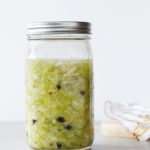




LACTO-FERMENTED VEGETABLES ARE AS EASY TO MAKE AS TOSSED SALAD
The main difference being that you set them in a cupboard for a week or so before eating. That might seem counter intuitive in our refrigerator-centric culture, but this age old practice has fortified the immune systems of people around the world as far back as food preparation can be traced.
Lacto-fermented foods are made by allowing lactobacilli (the bacteria present in especially high numbers on produce grown close to the ground) to brake down sugars and starches into lactic-acid. This acid acts as a natural preservative by inhibiting putrefying bacteria and helps to release cancer-fighting glucosinolates, minerals and enhanced bioavailable vitamins such as C and K2 in the process.
SCIENCE HAS ONLY BEGUN TO GRASP THE SCOPE OF THE INNUMERABLE BENEFITS
But the main premise is that by populating the gut and the body’s microbiome with probiotic microorganisms, lacto-fermented foods supply the immune-system with necessary assistance in fighting off infections, reducing inflammation and regulating metabolic processes in the body. These foods are therapeutic grade medicine for all manner of health conditions:
- Reduction in blood pressure
- Arthritis
- Asthma and allergies
- Skin problems
- Kidney problems
- Digestive issues
- Autoimmune disorders
- Anti-cancer activity–breast cancer in particular (source: PMID: 22716309)
EAT LACTO-FERMENTED FOODS AS PREVENTATIVE MEASURE
With astronomically higher efficacy rates than probiotic supplements, a couple spoonfuls of delicious, authentically fermented veggies supply the body with probiotic armies in the trillions. Because of our stomach acids and storage issues, a highly effective probiotic pill can only aim to supply you with a small fraction of the billions listed on the label. Save money and enhance your meals by making your own probiotic foods!
PREPARATION NOTES
Sauerkraut is one of my favorite lacto-fermented condiments. All it takes is a little elbow grease to effectively squeeze out those vital juices in the cabbage leaves. If you’re not ready to put in the labor, the Enzymatic Veggie Medley is an excellent first foray into probiotic food making.
Tips to keep in mind
- Use organic ingredients, to avoid polluting and inhibiting the enzymatic process, while also increasing the mineral content of your final product. (On the flip side, if you can’t get organic veggies, the fermentation process has been known to reduce pesticides.)
- Try using a cleaned, boiled stone to keep your kraut below the water.
- If you’re ready to invest in a no fuss lid complete with a spring to keep the veggies in place, try Kraut Source’s stainless steel fermentation lid.
- Skim and toss any brownish grime floating at the top of the jar when finished fermenting.
- I suggest you let your kraut ferment for 2 or more weeks, but if you’re feeling antsy give it a try at 7-10 days. If it tastes a bit too salty, let it ferment for the full 2 week period.
- If you’re fermenting in a cool climate, your fermentation times will be longer.
- Once you’ve gobbled up all those delicious veggies, reserve a 1/2 cup of the remaining probiotic brine for your next batch and drink the rest!




